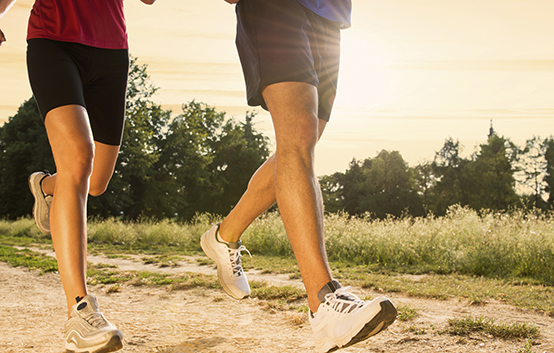With more spring-like temperatures these days, I’ve been thinking a lot about running. As I’ve shared, I love running in all four seasons – I’m not a fair weather fan! At this time of year, when people are itching to get outside more and shed their winter insulation, I’ve mostly been thinking about how to help others start a running program to add to their healthy lifestyle.
Before you cringe, and say “No way, lady. I’m NOT a runner!” let me share something with you…
When I was younger, I was a sprinter. I loved short distance running. The thought of doing much more than a lap around the track didn’t appeal to me in the least! In fact, it mostly made me want to toss my cookies. I saw no pleasure in that whatsoever!
The high school cross country coach somehow convinced me to try out for the team, so I did. (I was always such a “pleaser”… that’s the only reason I can think of to explain why on earth I felt the need to listen to this man!) I ran several meets, but never really got into it very much. I remember thinking, “Why am I doing this? Why can’t I breathe! Can’t I just run really, really fast… for a few seconds, and be done with it? Now THAT I can do!”
In university, I roomed with a marathoner who felt it was her duty to change my naïve ways! My runs got a little longer, but mostly because she and I had become great friends, so our runs together were a time to chat! She also helped me learn to breathe while running – a rather important skill!
I continued running over the years – mostly doing it because I felt I was “supposed to” in order to be healthy. It wasn’t until I went to a “Total Life Conditioning Boot Camp” that featured, among many other things, a running coach, that I truly began to enjoy long distance running.
I can still clearly recall the first “lesson” in running he gave us. To this day, I remember and apply the tips for easy and effective running.
Some of the best tips I’ve ever received for starting a running program or becoming a better runner are:
1) Let go of expectations.
Your running doesn’t need to look a certain way or be a certain distance or any particular speed or duration. This is between you and the ground you cover. Don’t take it so seriously!
If you set about the process of beginning a running program with the mentality that, “Every step I take is better than sitting on the couch,” then you’ll probably relax about the whole thing a lot more!
I used to psyche myself out with long distance running. If I started thinking about how far I “had to” go, my mental state of disdain would negatively effect my physical performance. I just started running… with no expectations. I just focused on putting one foot in front of the other, again, then again, then again! I learned to be in the moment, and enjoy it.
Whatever your starting point, just add a little more running to it. For example, if you’re a walker, then just add a light jog to your walk – a few times if you feel up to it. Jog for 30 seconds… jog for 5 minutes. It doesn’t matter how long, just give it a try. Gradually add to the process. You might add more jogging intervals or jog for longer periods of time. You might turn your jogging into more running. Whatever! No pressure! This is supposed to be enjoyable, remember?
If you’re already jogging or running, then maybe you don’t need any tips at all! Or maybe you can go farther, or faster, or experience less discomfort, or enjoy the process more. No pressure!
2) Run like an animal.
The boot camp running coach had us visualize how an innately powerful and beautiful runner, like the cheetah, moves across the ground. Their feet almost skim the surface of the ground, rather than slam into it as many humans do! Picture how a cheetah’s feet make contact with the ground – they don’t even have heels, so we can be fairly certain that heel contact doesn’t have anything to do with fabulous running!
I learned how to run “lightly”… to land closer to the ball of my foot and to visualize myself just lightly skimming across the ground, stepping more lightly as I went. (Not quite as fast as a cheetah, mind you!)
The visualization he gave us for this “light” running, in addition to the cheetah, was that of certain traditional nomadic tribes in other parts of our world who run together – as a community – as they travel for hours. He talked about how part of this ritual for the tribes has to do with their connection to the planet. They feel like their bare feet are essentially massaging Mother Earth. Gentle, rhythmic, light. Any members of the community who can walk participate in the running – even very young children and the elderly. That gives you a sense for how light and easy we could make our running!
I’ve never let this image go. It forever changed the way I run, how I feel during runs, and how my body is capable of running long distances with no joint pain.
3) Don’t complicate things.
Running (and jogging) is nothing more than a faster mode of transportation than walking! At least that’s how this coach got things started!
After explaining the concepts of running lightly and making contact with the ground gently with the forefront of the foot, he had us practice while running in place. Nice and gentle, until we got a feel for it. He wanted us to get to the point where we truly felt good with this. Easy breathing, in slowly through the nose at first, then the mouth, and out slowly through the mouth… letting go of tension, anxiety, AND any pain or discomfort.
That was a HUGE lesson for me – that if you can learn to relax “into” a run, you can actually work through and relieve aches and pains. Incredible! I’ve proven this physiological phenomenon to myself countless times in the past decade! (Actually, it has everything to do with “Proprioception” that I’ve discussed in earlier articles – it’s like movement nutrition for your brain, causing your brain to release endorphins and the “feel good” hormones, like serotonin.)
Anyhow, from the running easily in place, he said, “Now slightly shift your body weight a TINY bit forward… only enough to cause you to ‘fall’ forward out of the spot you’ve been running in. Continue the exact same style of running… only, let this minuscule shift in your center of gravity propel you forward… effortlessly!”
He was right!
I watched many people around me at this boot camp, who had never run a day in their lives, suddenly grin from ear to ear and laugh out loud at how easy and fun this was! (Although, I can’t say for sure that they were still laughing when we had to go out and run 10km on the first day at 4 a.m.!! But they DID it!)
The coach’s point was, find your comfortable place in your running style and technique, get your breathing nice and easy, and make sure you feel light and gentle with your foot contact (you shouldn’t feel knee or hip pain once you get the hang of this), and then just ‘lean into’ it to make yourself go forward.
No, you shouldn’t be bent over at the waist! The “lean forward” angle is only the smallest shift you can make in order to propel you. You don’t want to end up looking for pennies here! Keep your head over your shoulders, and your spine, as opposed to sticking out in front of you. This helps with your proper easy respiration as well.
Speaking of respiration, even though you’re running or jogging, keep your breathing as steady and rhythmic as you can. Many people will tell you that you should be able to carry on a conversation while running. I understand what they mean – you shouldn’t be gasping for air and near hyperventilating! But, you should be working hard enough to be breathing pretty darn heavy. As long as you keep it as steady as possible, you’re on the right track. Until I get into the ‘groove’ of my run, I often have to slip-and-check my breathing to calm it down. The adrenaline rush tends to get us breathing closer to the pace of our feet at times! Slow down your breathing, let your rib cage fully expand when you breathe… and you’re on your way!
In the next part of this Starting a Running Program series, I’ll discuss how to fit running into your schedule, as well as how to get the most out of your running when it comes to cardiovascular training, weight loss and fat loss.




